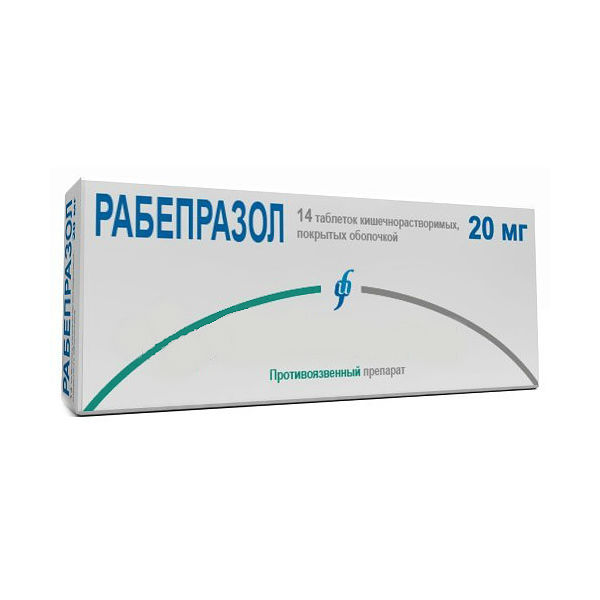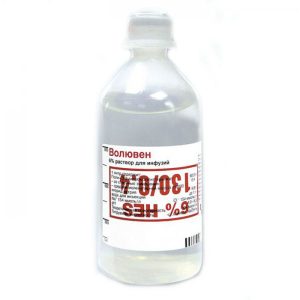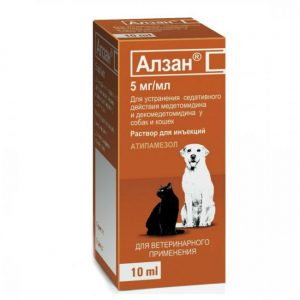Description
Pharmacological action
Antiulcer, inhibitor of H + -K + -ATPase (proton pump). The mechanism of action is associated with inhibition of the enzyme H + -K + -ATPase in the parietal cells of the stomach, which leads to blocking the final stage of the formation of hydrochloric acid. This action is dose-dependent and leads to inhibition of both basal and stimulated secretion of hydrochloric acid, regardless of the nature of the stimulus.
Pharmacokinetics
After oral administration, it is absorbed from the digestive tract. At a dose of 20 mg, Cmax is reached after 3.5 hours. Changes in Cmax and AUC are linear (in the range of doses from 10 to 40 mg). Absolute bioavailability is about 52% due to the effect of the first passage through the liver. The bioavailability of rabeprazole does not increase with repeated administration.
Meal and time during the day do not affect the absorption of rabeprazole.
Plasma protein binding is 97%.
Rabeprazole sodium is exposed to a first-pass effect. It is metabolized in the liver with the participation of CYP isoenzymes.
Major metabolites (thioester and carboxylic acid) and minor metabolites (sulfone, dimethylthioether and mercaptopuric acid conjugate) are present in low concentrations.
In healthy volunteers, T1 / 2 is about 1 hour, the total clearance is about 283. About 90% is excreted in the urine mainly in the form of two metabolites: a conjugate of mercaptopuric acid and a carboxylic acid. In toxicological studies in laboratory animals, 2 more unidentified metabolites were found. The rest is excreted in the feces.
In patients with stable end-stage chronic renal failure requiring hemodialysis (CC less than 5 ml / min / 1.73 m2), AUC and Cmax were 35% lower than in healthy volunteers. On average, T1 / 2 of rabeprazole was 0.82 hours in healthy volunteers, 0.95 hours in patients during hemodialysis, and 3.6 hours after hemodialysis. In kidney diseases, the clearance of rabeprazole in hemodialysis patients was approximately 2 times higher than in healthy volunteers.
In patients with mild or moderate chronic liver failure, an increase in Cmax, T1 / 2, and AUC was observed after a single dose of rabeprazole.
In the case of slow metabolism of CYP2C19 after taking rabeprazole at 20 mg / day for 7 days, AUC and T1 / 2 were 1.9 and 1.6, respectively, with extensive metabolism, while Cmax increased only by 40%.
In elderly patients, elimination of rabeprazole is somewhat slower.
Indications
Peptic ulcer in the acute stage and ulcer anastomotic
Duodenal ulcer in the acute stage
Erosive and ulcerative gastroesophageal reflux disease or reflux esophagitis
Maintenance treatment of gastroesophageal reflux disease
non-erosive gastroesophageal reflux disease
Zollinger-Ellison syndrome and other conditions characterized by pathological hypersecretion
In combination with appropriate antibacterial therapy for the era dictations of Helicobacter pylori in patients with peptic ulcer.
Contraindications
Hypersensitivity to rabeprazole, substituted benzimidazoles or to any of the excipients of the
preparation Pregnancy
Breastfeeding period
Age up to 12 years.
Precautions
Childhood
Severe renal failure.
Special instructions
The patient’s response to rabeprazole sodium therapy does not exclude the presence of malignant neoplasms in the stomach.
Rabeprazole tablets cannot be chewed or crushed. The tablets should be swallowed whole. It was found that neither the time of day nor the meal affects the activity of rabeprazole sodium.
In a special study in patients with mild or moderate hepatic impairment, there was no significant difference in the frequency of side effects of rabeprazole sodium from that of healthy individuals matched by sex and age, but despite this, caution is advised when first appointing rabeprazole sodium to patients with severe impaired liver function. The AUC of rabeprazole sodium in patients with severe hepatic impairment is approximately two times higher than in healthy volunteers.
Patients with impaired renal or hepatic function dose adjustment of rabeprazole is not required.
Hypomagnesemia
In the treatment of PPIs for at least 3 months, in rare cases, cases of symptomatic and asymptomatic hypomagnesemia have been reported. In most cases, these messages came a year after the therapy. Serious side effects were tetany, arrhythmia, and seizures. Most patients required treatment for hypomagnesemia, including magnesium replacement and discontinuation of PPI therapy. In patients who will receive long-term treatment or who are taking PPIs with drugs such as digoxin or drugs that can cause hypomagnesemia (such as diuretics), healthcare providers should monitor magnesium levels before and after treatment.
Patients should not take other antacids, such as H2-receptor blockers or PPIs, simultaneously with rabeprazole.
bone fractures
According to observational studies, it can be assumed that PPI therapy may increase the risk of hip, wrist, or spinal fractures associated with osteoporosis. The risk of fractures was increased in patients who received high doses of PPI for a long time (year or more).
Concomitant use of rabeprazole with methotrexate
According to published data, concomitant use of PPIs with methotrexate (primarily in high doses) can increase the concentration of methotrexate and / or its metabolite hydroxymethrexate and increase the half-life, which may lead to the manifestation of toxicity of methotrexate. If you need to use high doses of methotrexate, the possibility of a temporary cessation of PPI therapy may be considered.
Clostridium difficile
IPP therapy may increase the risk of gastrointestinal infections such as Clostridium difficile.
Effect on the ability to drive vehicles and mechanisms
Based on the pharmacodynamics of rabeprazole and its profile of undesirable effects, it is unlikely that it affects the ability to drive a car and operate machinery. However, in case of drowsiness, these activities should be avoided.
Composition
1 enteric coated tablet 20 mg contains:
Composition of the tablet core:
Active ingredient: rabeprazole sodium – 20.0 mg, corresponds to rabeprazole – 18.85 mg.
Excipients: magnesium oxide, low-substituted hyprolose (hydroxypropyl cellulose), mannitol, hypromellose, sodium stearyl fumarate.
Composition of the shell of tablets 1: opadry colorless 03K19229 (hypromellose, triacetin, talc), magnesium oxide.
Composition of the shell of a tablet 2: shureliz colorless E-7-19040 (ethyl cellulose, ammonium hydroxide, medium chain triglycerides, oleic acid).
Composition of the tablet shell 3: acrylis II yellow 493Z220000 (methacrylic acid and ethyl acrylate copolymer (1: 1), talc, titanium dioxide, poloxamer 407, calcium silicate, sodium bicarbonate, sodium lauryl sulfate, yellow iron dye).
Dosage and administration
Rabeprazole tablets cannot be chewed or crushed. The tablets should be swallowed whole. It was found that neither the time of day nor the meal affects the activity of rabeprazole sodium
. In case of gastric ulcer in the acute stage and an anastomotic ulcer, it is recommended to take 20 mg orally once a day. Usually, cure occurs after 6 weeks of therapy, but in some cases, the duration of treatment can be increased by another 6 weeks.
In case of peptic ulcer of the duodenum, it is recommended to take orally 20 mg once a day. The duration of treatment is from 2 to 4 weeks. If necessary, the duration of treatment can be increased by another 4 weeks.
In the treatment of erosive gastroesophageal reflux disease or reflux esophagitis, it is recommended that you take 20 mg orally once a day. The duration of treatment is from 4 to 8 weeks. If necessary, the duration of treatment can be increased by another 8 weeks.
With maintenance therapy for gastroesophageal reflux disease, it is recommended that you take 20 mg orally once a day. The duration of treatment depends on the patient’s condition.
In non-erosive gastroesophageal reflux disease without esophagitis, it is recommended to take 20 mg orally once a day. If after four weeks of treatment the symptoms do not disappear, an additional examination of the patient should be carried out. After stopping the symptoms, to prevent their subsequent occurrence, the drug should be taken orally once a day upon request.
For the treatment of Zollinger-Ellison syndrome and other conditions characterized by pathological hypersecretion, the dose is selected individually. The initial dose is 60 mg per day, then the dose is increased and the drug is prescribed in a dose of up to 100 mg per day with a single dose or 60 mg twice a day. For some patients, fractional dosing of the drug is preferred. Treatment should continue as needed. In some patients with Zollinger-Ellison syndrome, the duration of treatment with rabeprazole was up to one year.
For eradication of Helicobacter pylori it is recommended to take orally 20 mg 2 times a day according to a certain scheme with the appropriate combination of antibiotics. The duration of treatment is 7 days.
Patients with Renal and Hepatic Insufficiency
Dose adjustment is not required for patients with renal failure.
In patients with mild to moderate hepatic insufficiency, the concentration of rabeprazole in the blood is usually higher than in healthy patients.
Caution is advised when prescribing rabeprazole to patients with severe hepatic impairment.
Elderly patients
Dose adjustment not required.
Children
The safety and effectiveness of rabeprazole sodium 20 mg for short-term (up to 8 weeks) treatment of gastroesophageal reflux disease in children aged 12 years and more is confirmed by extrapolation of the results of adequate and well-controlled studies that support the effectiveness of rabeprazole sodium for adults, and safety and pharmacokinetic studies for pediatric patients.
The recommended dose for children aged 12 years or more is 20 mg once a day for up to 8 weeks.
Safety and efficacy of rabeprazole sodium for the treatment of gastroesophageal reflux disease in children under the age of 12 have not been established. The safety and effectiveness of rabeprazole sodium for other indications have not been established for pediatric patients.
Side effects
The following classification is used to determine the incidence of side effects of the drug: very often ( 1/10) often ( 1/100 and <1/10) infrequently ( 1/1000 and <1/100) rarely ( 1/10000 and <1/1000) is very rare (<1/10000), including isolated cases. Immune system disorders: rarely – acute systemic allergic reactions. Disorders from the blood and lymphatic system: rarely – thrombocytopenia, neutropenia, leukopenia. Disorders from metabolism and nutrition: rarely – hypomagnesemia. Disorders from the liver and biliary tract: increased activity of liver enzymes, rarely hepatitis, jaundice, hepatic encephalopathy Disorders from the kidneys and urinary tract: very rarely – interstitial nephritis. Disorders of the skin and subcutaneous tissues: rarely – bullous rashes, urticaria very rarely – erythema multiforme, toxic epidermal necrolysis, Stevens-Johnson syndrome. Violations of the musculoskeletal and connective tissue: rarely – myalgia, arthralgia. Disorders from the genitals and mammary gland: very rarely – gynecomastia. Changes in other laboratory parameters during the administration of rabeprazole sodium were not observed. According to post-marketing observations, proton pump inhibitors (PPIs) may increase the risk of fractures. Overdose of Symptoms of Data on intentional or accidental overdose is minimal. No cases of severe overdose of rabeprazole were noted. Treatment The specific antidote is unknown. Rabeprazole binds well to plasma proteins and therefore is poorly excreted during dialysis. In case of an overdose, symptomatic and supportive treatment is necessary. Storage conditions In the dark place at a temperature of no higher than 25 ° C. Keep out of the reach of children. Expiration 2 years. Do not use after expiration date. Deystvuyuschee substances Rabeprazole prescription Prescription dosage form tablets




